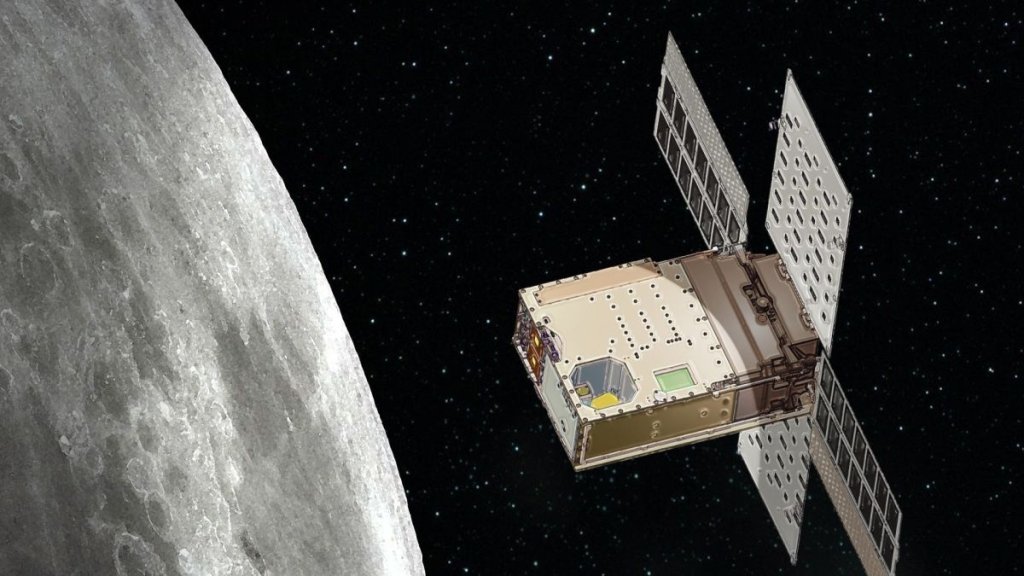
NASA gives up on tiny Lunar Flashlight probe’s troubled moon ice mission (Image Credit: Space.com)
NASA has given up on the planned moon mission of its tiny Lunar Flashlight cubesat, which aimed to hunt for water ice in shadowy craters near the moon’s south pole.
The briefcase-sized Lunar Flashlight launched atop a SpaceX Falcon 9 rocket last December. It was a ride-along payload on a mission whose chief aim was to send the private Japanese company ispace’s robotic Hakuto-R lander toward the moon.
Lunar Flashlight was supposed to be moon-bound as well. But it experienced problems with its technology-demonstrating propulsion system, failing to generate enough thrust to reach lunar orbit as planned.
The mission team troubleshot the problem for nearly six months but couldn’t crack it. So, today (May 12), NASA announced that it was calling an end to Lunar Flashlight’s planned mission.
“Technology demonstrations are, by their nature, higher risk and high reward, and they’re essential for NASA to test and learn,” Christopher Baker, program executive for Small Spacecraft Technology in the Space Technology Mission Directorate at NASA headquarters in Washington, D.C., said in a statement (opens in new tab) today.
“Lunar Flashlight was highly successful from the standpoint of being a testbed for new systems that had never flown in space before,” Baker added. “Those systems, and the lessons Lunar Flashlight taught us, will be used for future missions.”
Related: These two tiny spacecraft will help pave the way for astronauts to return to the moon
Among those successes, NASA officials said, were the cubesat‘s Sphinx flight computer, a low-power, radiation-resistant variant developed by the agency’s Jet Propulsion Laboratory in Southern California, and the probe’s upgraded radio, known as Iris.
“Featuring a new precision navigation capability, the radio can be used by future small spacecraft to rendezvous and land on solar system bodies,” NASA officials wrote in today’s statement.
The mission team also successfully tested Lunar Flashlight’s four-laser reflectometer, suggesting that it could indeed have spotted water ice on the floors of moon craters.
“It’s disappointing for the science team, and for the whole Lunar Flashlight team, that we won’t be able to use our laser reflectometer to make measurements at the moon,” Barbara Cohen, the mission’s principal investigator at NASA’s Goddard Space Flight Center in Greenbelt, Maryland, said in the same statement.
“But like all the other systems, we collected a lot of in-flight performance data on the instrument that will be incredibly valuable to future iterations of this technique,” Cohen said.
Lunar Flashlight’s miniaturized propulsion system was a new type of technology as well, employing 3D-printed parts and “green” propellant. It appears that the thrusters’ fuel-feed system got clogged with some type of debris — metal shavings or powder, perhaps — that prevented them from firing at full capacity, NASA officials said.
Mission team members tried several tactics to dislodge the debris, including increasing the fuel pressure to levels far above normal. But nothing worked in time for the probe to achieve its planned lunar orbit.
But Lunar Flashlight isn’t necessarily dead. Most of the probe’s systems are still functioning well, and NASA could end up assigning it a new task.
“After having traveled out past the moon, Lunar Flashlight is now moving back toward Earth and will fly past our planet with a close approach of about 40,000 miles (65,000 kilometers) on May 17,” agency officials wrote in today’s update. “The cubesat will then continue into deep space and orbit the sun. It continues to communicate with mission operators, and NASA is weighing options for the future of the spacecraft.”
Lunar Flashlight’s ride-along partner also failed to achieve all of its mission goals: Hakuto-R ended up crashing during its lunar landing attempt on April 25. But, like Lunar Flashlight, the Japanese lander notched a number of successes along the way. For example, it successfully reached lunar orbit, demonstrating the viability of many of the systems ispace will use on future lunar missions.
Mike Wall is the author of “Out There (opens in new tab)” (Grand Central Publishing, 2018; illustrated by Karl Tate), a book about the search for alien life. Follow him on Twitter @michaeldwall (opens in new tab). Follow us on Twitter @Spacedotcom (opens in new tab) or Facebook (opens in new tab).






